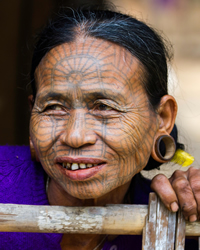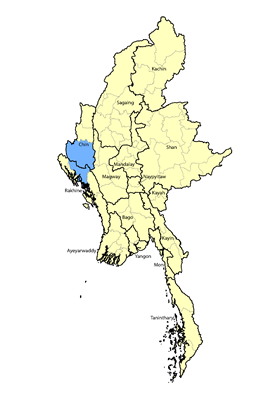Although their language is called Songlai, this group is often referred to as Yindu by outsiders. As an indication of the incredibly complex ethnic diversity in the region, the Songlai were first identified by the British in 1890, who considered them one of 32 different tribes of Daai Chin people. Today, the Songlai are considered one of four subgroups of the Letu tribe, although the Letu vernaculars are distinct enough to warrant two separate Bible translations. The Songlai remain one of the lesser-known tribes in Myanmar today due to their remote location and different culture.
Location: Numbering over 8,000 people, the Songlai tribe inhabits villages along the banks of the Lemro (also spelled Laymyo) River in southwest Myanmar. Their mountainous territory straddles both sides of the border between Paletwa Township in Chin State and south into Mrauk-U Township in Rakhine State. The Songlai population appears to be evenly divided between the two regions, with at least 13 villages in Chin State and a similar number across the border in Rakhine State. Several other tribes are neighbors of the Songlai, with the Daai to the north; Letu and Uppu to the east; and the Hnise and Mro-Khimi to the north.
Language: Songlai is a distinct unwritten language which enjoys widespread use in their communities. Studies show that despite Songlai having a lexical similarity of over 90 percent with Letu, the two languages share low intelligibility. In laymen's terms, this means that speakers of each vernacular cannot understand each other unless they communicate in a third language, such as Burmese. Seven dialects have been identified among the Songlai, some of which may represent distinct people groups.
According to one local source, the ancestors of the Letu “migrated from the Mon River and the Minbu District of Magway Region in 11 and 12 AD.” If accurate, the Songlai have lived in their current location since the time Jesus Christ walked on the earth. The Songlai are one of the tribes in Chin State that traditionally tattooed girls' faces at puberty, although evidence of this custom is only seen on elderly women today, as it was outlawed in the 1960s. Songlai tattoos are said to be “one of the more intricate and painful among the Chin peoples and were often completed over four or five separate sessions so the girls could bear the pain…. It was simply a part of life. When it was done, a girl became a woman and could marry. Unlike other peoples of the area, they were never forced to stop tattooing. But as other tribes stopped, the Songlai no longer saw the need for tattoos and followed suit.”
Most Songlai homes are located near a stream and are simple bamboo or wooden structures with thatch roofs. Hunting continues to play an important role in Songlai society due to the abundance of wildlife in the pristine forests in the area and the difficulty in growing crops because of the steep terrain. Despite their poverty, Songlai women adorn themselves with elaborate earrings and necklaces, which are handed down as family heirlooms and locked away in chests in their homes.
In the past the Songlai were animists, and although most Songlai people now say they are Buddhists, in reality their belief system continues to be spirit worship beneath a veneer of Buddhism, especially those living in Rakhine State. Unlike almost all other Chin tribes in Myanmar, most Songlai families have not accepted Christianity, which is practiced by only about one-tenth of the population.
The Songlai are one of the least Christian Chin groups in Myanmar, with no Scripture or Gospel resources of any kind available in their language. Although it may be true that most Songlai people have never heard a clear presentation of the Gospel, many are content with their current religious lives and see little need for change.
Scripture Prayers for the Songlai in Myanmar (Burma).
| Profile Source: Asia Harvest |











